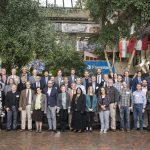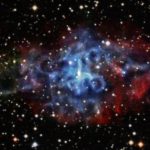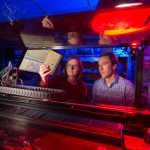LHC
The USCMS collaboration has received approval from the Department of Energy to move forward with final planning for upgrades to the giant CMS particle detector at the Large Hadron Collider. The upgrades will enable it to take clearer, more precise images of particle events emerging from the upcoming High-Luminosity LHC, whose collision rate will get a 10-fold boost compared to the collider’s design value when it comes online in 2027.
From CERN, Dec. 3, 2019: Large-scale scientific facilities, such as those for conducting particle physics research, are financed by society. A team of economists recently performed a cost-benefit analysis of upgrading the Large Hadron Collider. They concluded that the socioeconomic and cultural benefits gained from the project — not including potential scientific discoveries — exceed the total pecuniary investment.
This summer, physicist Larry Lee had festival-goers dancing to the sounds of science. He uses his musical training and an interest in collider machinery to create a new instrument of sorts. Using a piece of standard lab equipment, Lee has created a science-inspired, electronic music-backed light show.
From CERN, Oct. 7, 2019: The CMS collaboration has measured for the first time the variation, or “running,” of the top quark mass. The theory of quantum chromodynamics predicts this energy-scale variation for the masses of all quarks and for the strong force acting between them. Observing the running masses of quarks can therefore provide a way of testing quantum chromodynamics and the Standard Model.
From DOE, Sept. 10, 2019: Fermilab scientist Bo Jayatilaka is quoted in this article on ESnet, which has expanded to connect more than 40 major research institutions at speeds 15,000 times faster than a home network.
For years, U.S. institutions have been working to upgrade the hardware in the behemoth CMS particle detector at the Large Hadron Collider, enabling it to profit fully from the LHC’s increasing collision energy and intensity. With CD-4 approval, the Department of Energy formally recognized that the USCMS collaboration, managed by Fermilab, met every stated goal of the upgrade program — on time and under budget.
From MIT News, Aug. 19, 2019: A new prototype machine-learning technology co-developed by Fermilab and MIT scientists speeds Large Hadron Collider data processing by up to 175 times over traditional methods.






